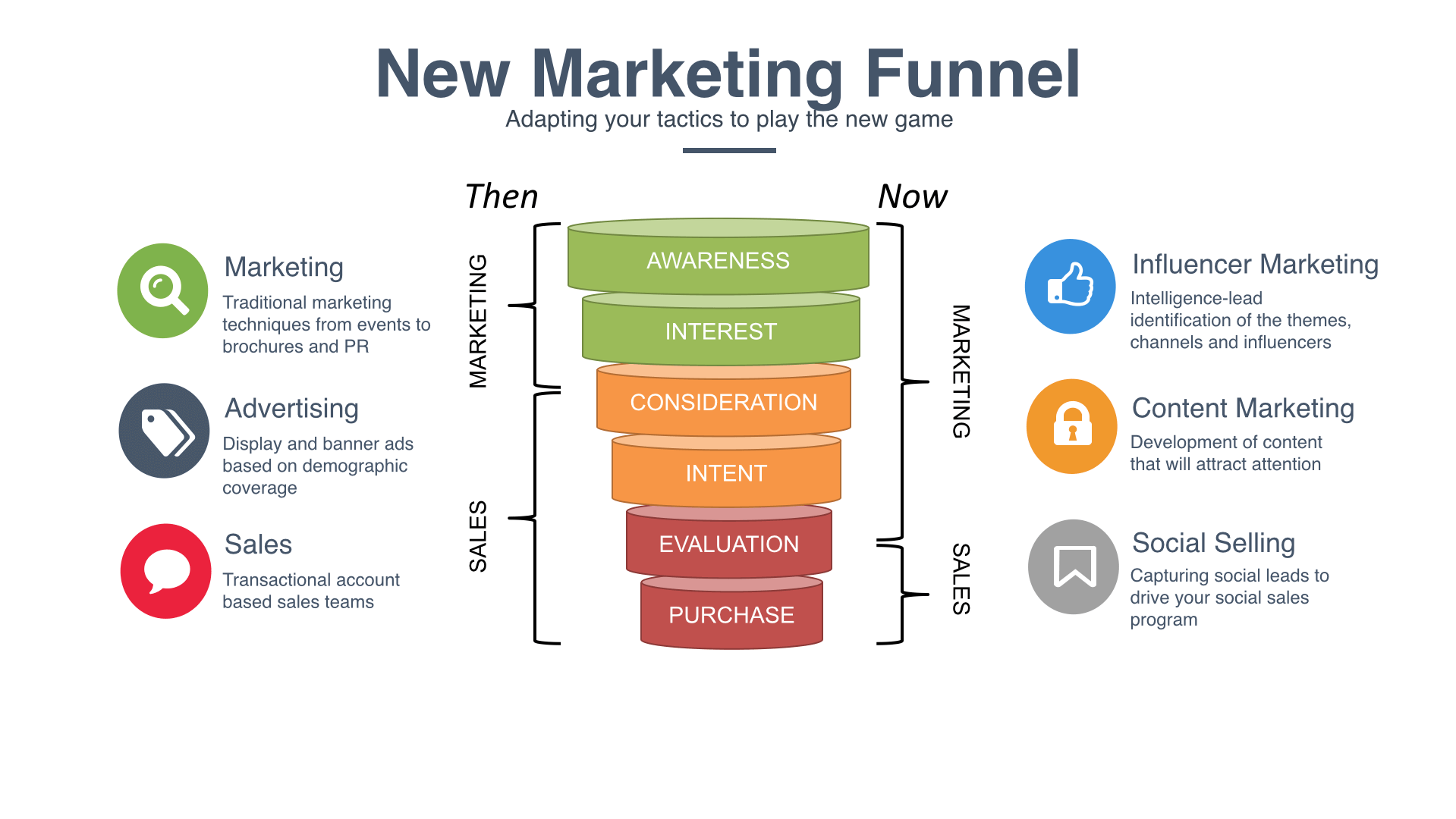Maybe it’s time to explain in more depth the meaning and importance of influence, as well as the best ways of measuring it.
1) Why is influence so important? What’s all the fuss about?
The world has changed – the way that we all purchase things is very different from the way that we used to do so and unless your marketing strategy and capability has adapted and evolved to address this change, you are being left behind. In the past our marketeers focused on big events, PR and advertising, while sales teams were focused on account based selling. As purchasers we might have reached the consideration point and then attended a trade show, visiting the stands of all the main vendors to find out more about what they had to offer, before reaching the point of intent or evaluation.
Buyers simply don’t act this way any more. They do all their research online, searching via google, researching via social media and seeing what the so called experts have to say and drawing up a short list without having seen or spoken to any vendors.
Signs that you’re stuck in the old world are:
- You’re still attending trade shows and wondering why all the foot-fall is other vendors. Why does it feel so empty? Where are all the punters?
- You’re still spending money on adverts in publications or banner ads on news sites. Even children these days have learned to tune out when they see adverts. Why would you think that buyers would be any different?
- You’re still focusing on media and analyst relations as if press and analysts were still the only real influencers?
- Worst of all though: you’re kidding yourself that you’ve moved with the times by posting content on your web site and by setting up a corporate Twitter account. When the reality is that 90% of all content marketing gets NO reaction – a massive wasted effort and opportunity cost.
[easy-tweet tweet=”The reality is that 90% of all content marketing gets NO reaction” user=”billmew and @comparethecloud” hashtags=”marketing”]
2) What is Influencer Relations really all about?
Influencer Relations is all about identifying and reaching the people that have real influence, and sharing content with them that will have real impact and really get their attention. Influencer Relations needs to be an integrated part of the new marketing continuum that includes both Content Marketing and Social Selling. For all of this to be effective you need real data-driven insights and answers to the questions below:
3) So how do you measure influence and how can you identify the real influencers?
Here are a few pointers that should help you differentiate the Compare the Cloud influence ranking from the alternatives:
Where are they looking?
There are many tools out there that will give you various statistical analyses based on social media data, but social media while important is only part of the equation. We are very active on social media and are massive advocates of its use, but we are realistic in the share of voice and attention that it represents. Our monthly analysis looks at a far broader set of media. The balance between these is dynamic and based on the volume, level of opinion and real influence being applied across each at any time: currently this balance for cloud computing is as follows: 22.6% from blogs, 74.4% from news articles and 3.0% from social media. Any ranking that purely looks at social media is only assessing 3.0% of the overall spectrum.
[easy-tweet tweet=”Any ranking that purely looks at social media is only assessing 3.0% of the overall spectrum.” user=”comparethecloud”]
What are they measuring?
For our rankings we use tools that measure influence as it is demonstrated in public news, articles, discussions, and social media. We apply patented natural language processing algorithms to first extract opinions that have been publicly shared relative to a specific topic definition, then determine who held that opinion, and finally calculate an influence score for the opinion, opinion holder, and the topic. This process is repeated every day, using the full-text articles from over 3 million sources including news, blogs, and social media.
[easy-tweet tweet=”For #Cloud Computing @Comparethecloud is currently tracking 637,607 identified opinions” user=”billmew” hashtags=”cloudinfluence”]
For Cloud Computing we are currently tracking 637,607 identified opinions and the day to day variations in our influencer analysis are shown in the graphs that accompany our rankings.
By comparison a table that simply focusses on social media without isolating individual opinions and analysing each in turn, simply does an analysis of tweets mentioning certain prominent hashtags, and counts the number of followers.
What results do they get?
Our rankings change from month to month and are closely aligned to the news agenda, we provide a ‘Global Top 50’ list of the leading #CloudInfluence organisations and individuals and can at any time identify the main opinions expressed by each. If you’d like to scrutinise our results or commission us to do a more in depth analysis of any market segment then we be happy to discuss this with you.
Important conclusion
Don’t let misleading social media based analysis put you off or misdirect you.
The thing is that Influencer Relations is an important part of the modern marketing continuum and that identifying and reaching the right influencers is critical. Don’t let misleading social media based analysis put you off or misdirect you. Instead get the right advice and focus back on the real data-driven insights that we listed earlier that you need to be able to address in order to be effective.
Bill is a tech industry veteran and experienced corporate marketing and communications professional with over 20 years spent working in blue chip organisations mostly in pan-European and global communications roles. He is also a regular commentator on #Cloud, #SocialSelling and #InfluencerMarketing, as well as a dad with a passion for technology, economics, politics & Arsenal FC.




